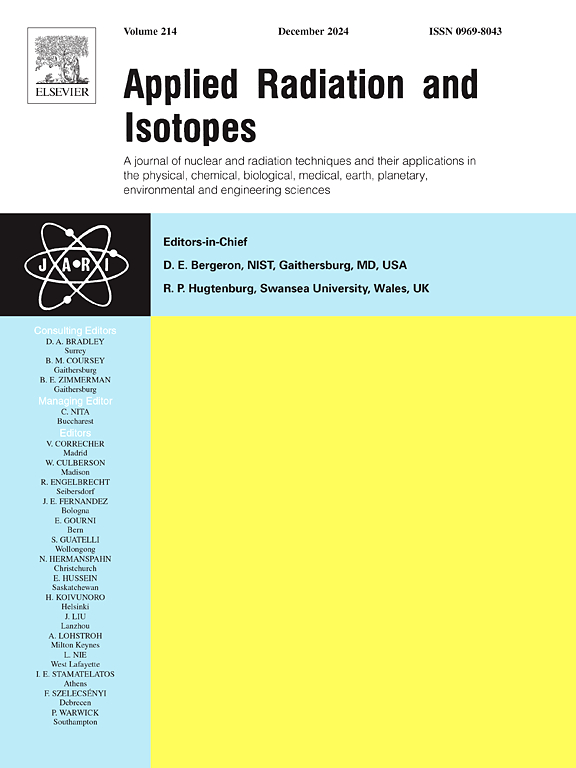碘-123的标准化和参与BIPM.RI(II)-K4.I-123的比较
IF 1.8
3区 工程技术
Q3 CHEMISTRY, INORGANIC & NUCLEAR
引用次数: 0
摘要
碘-123采用4π(eA,X)-γ实时反符合计数技术进行标准化,4π通道采用液体闪烁(LS)计数。在4天内统计了7个LS源。为了追踪杂质125I, 121Te和123mTe的衰变,在100天内对一个源进行了额外的9次计数。将扩展数据集拟合到放射性核素成分的衰变函数中,提供了杂质校正因子。对记录的数据进行背景、活时间、杂质和衰变校正,并绘制为NLSNγNC vs (NγNC−1)。加权最小二乘回归和外推到(NγNC−1)=0提供源活度。数据用二阶系数为零的三阶多项式拟合,以考虑数据中存在的曲率。一阶多项式拟合提供了1.02%的活性浓度高。这一主要标准是作为ANSTO参与BIPM的一部分而制定的。国际扶轮k4 (II)。I-123键比较,使用国际参考系统转换工具(SIRTI)。提交参与互比较的结果比本文报道的结果高0.85%。重新评价后,标准不确定度由0.36%增加到0.53%,主要是由于检测效率曲线的非线性外推。本文章由计算机程序翻译,如有差异,请以英文原文为准。
Standardisation of iodine-123 and participation in the comparison BIPM.RI(II)-K4.I-123
Iodine-123 was standardised by the 4π(eA,X)-γ live-timed anti-coincidence counting technique, with liquid scintillation (LS) counting applied for the 4π channel. Seven LS sources were counted over 4 days. To trace the decay of impurities 125I, 121Te and 123mTe, one source was counted for an additional 9 times over 100 days. Fitting the extended dataset to the decay function for the component radionuclides provided impurity correction factors. The recorded data were corrected for background, live time, impurities and decay, and plotted as vs . Weighted least squares regression and extrapolation to provided the source activity. Data were fitted with a 3rd order polynomial with the 2nd order coefficient = zero to account for curvature present in the data. A 1st order polynomial fit provided an activity concentration that was 1.02 % higher.
This primary standard was developed as part of ANSTO's participation in the BIPM. RI(II)-K4. I-123 key comparison, using the Transfer Instrument of the International Reference System (SIRTI). The result that was submitted for participation in the inter-comparison was 0.85 % higher than the result reported in this manuscript. With the latest re-evaluation, the standard uncertainty increased from 0.36 % to 0.53 %, mostly due to the non-linear extrapolation of the detection efficiency curve.
求助全文
通过发布文献求助,成功后即可免费获取论文全文。
去求助
来源期刊

Applied Radiation and Isotopes
工程技术-核科学技术
CiteScore
3.00
自引率
12.50%
发文量
406
审稿时长
13.5 months
期刊介绍:
Applied Radiation and Isotopes provides a high quality medium for the publication of substantial, original and scientific and technological papers on the development and peaceful application of nuclear, radiation and radionuclide techniques in chemistry, physics, biochemistry, biology, medicine, security, engineering and in the earth, planetary and environmental sciences, all including dosimetry. Nuclear techniques are defined in the broadest sense and both experimental and theoretical papers are welcome. They include the development and use of α- and β-particles, X-rays and γ-rays, neutrons and other nuclear particles and radiations from all sources, including radionuclides, synchrotron sources, cyclotrons and reactors and from the natural environment.
The journal aims to publish papers with significance to an international audience, containing substantial novelty and scientific impact. The Editors reserve the rights to reject, with or without external review, papers that do not meet these criteria.
Papers dealing with radiation processing, i.e., where radiation is used to bring about a biological, chemical or physical change in a material, should be directed to our sister journal Radiation Physics and Chemistry.
 求助内容:
求助内容: 应助结果提醒方式:
应助结果提醒方式:


